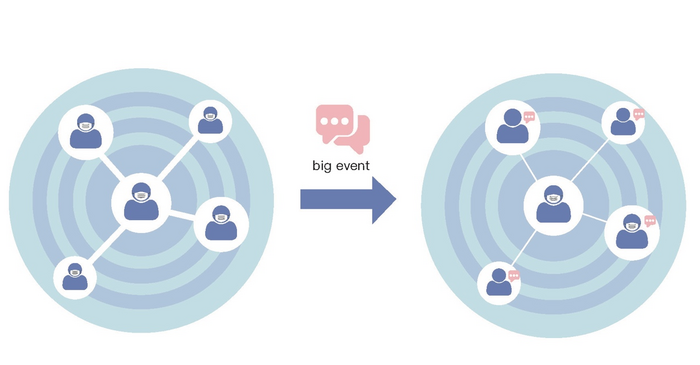The research team from the Computational Communication Collaboratory of Nanjing University and the Complex Systems Group of the University of Western Australia, hypothesize that raising people's awareness of disease is one of the most effective ways to prevent epidemic spreading, as it will change people's behavior, better inform them of appropriate protective measures, and thus reduce the probability of infection. Improving people's awareness of diseases requires the continuous and effective dissemination of scientific information related to infectious diseases. However, the dissemination of information related to infectious disease competes with the dissemination of discussion around major social events, as well as the dissemination of information such as false news and rumors.
To understand the impact of major social interference events, the research team proposed a two-layer network communication model that reflects how major social events affect the spread of epidemic prevention knowledge and the growth of cases, based on the SIR model that is renowned in the field of applied mathematics.
Taking the United States as an example, the authors use three real data sets to compare with the model, including the confirmed data of the United States, the topic data of Twitter, and the forwarding of scientific literature on Twitter. The research team found that their model was consistent with the behavior of all the three data sets at the same time. Specifically, two specific major events explain the trend of the coronavirus epidemic in the United States: the international online agenda setting of Donald Trump in early stage of the epidemic, and, the 2020 U.S. Presidential election. These events coincided with a worsening of infection in the United States. Research shows that major social events during the epidemic period will lead to the disturbance of scientific information dissemination, and will increase the prevalence of infection. Their theoretical model provides a mechanism for the distraction of attention and dilution of information propagation in response to an epidemic.
CSIRO-UWA chair of complex systems, professor Michael Small, pointed out that the model matches both qualitatively and quantitatively the events surrounding the 2020 COVID-19 outbreak in the United States and the concurrent political environment: "The model provides a plausible explanation - consistent with data - for the timing and relatively severity of the 2020 COVID-19 waves in the United States. The practical consequences of this are two-fold. First, in a general sense our work provides a cautionary lesson around the effect of distracting from important public health messages, Second, it provides a more concrete way to understand the link between the timing of protective information dissemination and infection. Lessons from this modelling have been used by at least one of our governments to better managed the control of COVID-19 in their own jurisdiction."
